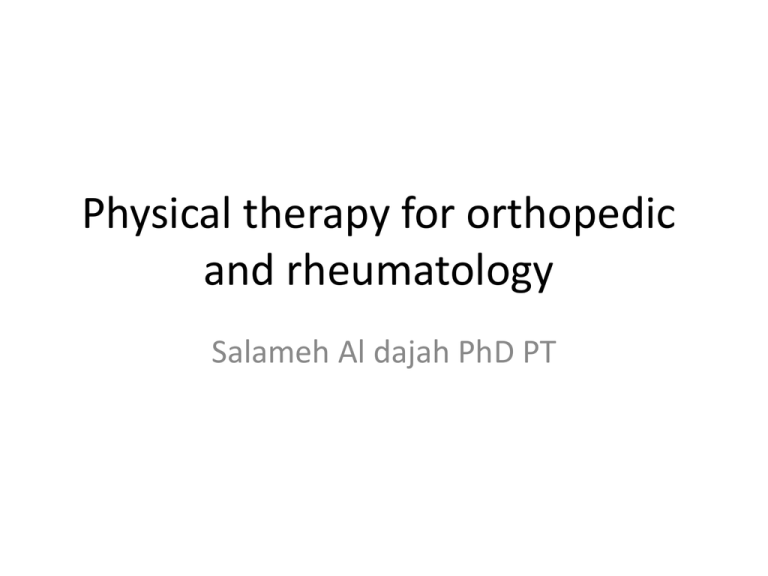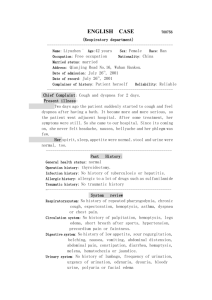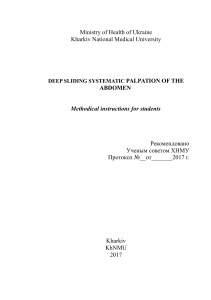Physical therapy for orthopedic and rheumatology Salameh Al dajah PhD PT
advertisement

Physical therapy for orthopedic and rheumatology Salameh Al dajah PhD PT Types of Pathology Principles of musculoskeletal pathology Four levels of diagnosis 1. Pathology Tissue abnormality such as Fracture, avulsion, dislocation, DJD (any disease) 2. Impairment Manifestation of the tissue abnormality such as, motion limitation, strength deficits, neurological abnormalities, 3. Functional limitation Activity limitation such as limitation in ability of walking, climbing, lifting 4. Disability Inability to perform a desired social role such as working, interacting with friends, going to school Evaluation Evaluation in Physical Therapy include Subjective findings 1. Taking History of present illness and past medical history - directly from the patient or his family - from patient record 2. Observation, Body appearance, tilting, limping, bending • 3. Palpation: palpate the area of complaint, touch for swelling, redness, warmness, deformity • Objective findings • 1. Taking measurement • ROM • MMT • neurological test for sensation, pain and temperature • Specific test to differentiate specifically Assessment • Assessment include Problem list What patient can do and cannot do and the level of assistant Goals list: Achievable and reachable goals, Patient must understand and agree on the goals • Plan: what we need to do to achieve the goals, Treatment plan, ways of treatment, and home treatment plan Differential Diagnosis of Musculoskeletal pathology • Bone pathology may results from direct or indirect trauma to the area or due metabolic • Diagnosis of fractures and medical management falls within the practice area of orthopedic surgery. Other bone pathology include • Avulsion (Osgoid process) • Dislocation (Shoulder dislocation) • Metabolic bone diseases (Osteoporosis) Notes from the history of musculoskeletal injuries Pain with any contraction palpable muscle tenderness Unaccustomed overuse and Unaccustomed violent contraction • Muscle: Pain with isometric contraction, Palpable tendon tenderness, Recent repetitive activity, Painful arc • Tendon: Pain at rest Palpable bursa tenderness, Due recent unaccustomed overuse, or recent weight bearing overuse. • Bursa: Pain with unidirectional movement, Due trauma in Unguarded movement • Capsule: Pain with ligament stress Palpable ligament tenderness Trauma Prolonged static position. • Ligament: Symptom location change with repeated movement Recurring episodes Worse with flexion activities • Disc: Positive nerve tension tests Palpable nerve tendernessParasthesia/ numbness/weakness Lancinating pain • Nerve/ Dura: Positive slum test Multisegmental pain reference Grading tenderness on palpation • Grade 1. Patient complain of pain • Grade 2. Patient complains of pain and wines • Grade 3. Patient complains of wines and withdraws the joint • Grade 4. Patient will not allow palpation of the injured area or joint


